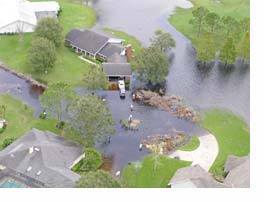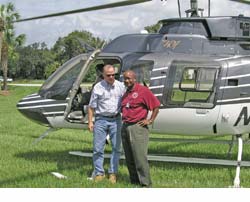Dazed But Not Defeated
West-central Florida was rocked against the ropes by a one-two punch combination — Hurricanes Charley and Frances.
Charley was a quick, compact, uppercut with winds in excess of 145 mph ramming into the underbelly of the Southwest Florida Water Management District and ripping through the rural Peace River Basin.
Then, still reeling from Charley, the area was slammed by Frances, a large, infuriatingly slow but devastating roundhouse right, cutting across the peninsula and saturating the District.
Dazed, damaged, but not defeated, federal, state and local governments, volunteer organizations and the communities in the Southwest District rallied to begin the rebuilding process.
“I’m amazed by the resiliency of the people of west-central Florida,” said District Executive Director David L. Moore. “Anything can be achieved when everyone works together. And in this crisis, that’s exactly what happened.”
HURRICANE CHARLEY
The hurricane season began as it usually does with meetings among state officials and training in emergency operations procedures. In May, a District memo on emergency preparedness was distributed to all employees.
In early August, the District’s Operations Department, which continuously monitors storm activity, noted the development of Tropical Storms Bonnie and Charley. The storms prompted discussions with Operations Director Gary Kuhl and the District’s executive staff about necessary preparations in the event that the District would be impacted.
“We hadn’t been threatened with a Category 3 or 4 hurricane in a long time. Preparation was crucial to ensure that everyone knew their assigned roles in the coming days and weeks,” Moore said.
On Wednesday, August 11, Charley became a hurricane and was considered a potential threat to the 16-county District. Charley was expected to impact the Florida Keys on the evening of August 12. The path of the hurricane was still uncertain, but most forecast models predicted it to travel north along Florida’s west coast by the morning of Friday, August 13. The Governor issued a state of emergency for Hurricane Charley and Tropical Storm Bonnie. The tropical storm made landfall in the Florida panhandle.
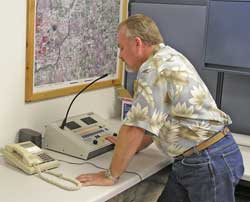
The District mobilized. One of the first priorities was effective communication with staff, Governing and Basin Board members and the State Emergency Operations Center. The executive director distributed a memo informing staff about the storm and District preparations. The memo would become the first in a continuing line of daily updates communicating with staff and board members through both hurricanes.
The Operations field crews acquired 15,000 sandbags and attached sandbagging equipment to District trucks. Water control structures were inspected and opened to create storage for anticipated rain from the hurricane. New emergency contact lists were distributed and pagers were provided to key Operations staff as backup to cell phone and radio communications.
Telephone lines and services to the District’s Emergency Operations Center (EOC) in Brooksville were verified to be operational. An alternate power supply for the telephone switch was connected to ensure that calls could be routed to the EOC.
On August 12, it was clear that Charley would make landfall somewhere in the District the next day. The District EOC in Brooksville was fully activated on a 24/7 basis with emergency response staff from multiple departments on-site. The District offices were closed. Diversions of water from the Hillsborough River to the Tampa Bypass Canal were increased to prevent flooding. Water levels at District structures were lowered across the region in preparation.
Initial projections called for the storm to slam into Pinellas County. Massive storm surges predicted for Tampa Bay raised concerns about the structures on the Hillsborough River and the Tampa Bypass Canal.
“We have a number of structures that provide critical flood relief to the cities of Tampa and Temple Terrace,” Moore said. “We had never had a storm this size push a tidal surge of 15 feet or more against these structures. What impact would such a surge cause? How extensive would the flooding be?”
The waiting game began.
Friday the 13th, Moore issued an executive order placing District staff and equipment on emergency standby to assist state, county, municipal or local governments and authorizing expedited approvals for emergency repairs or temporary construction to mitigate damages from the hurricane.
The hurricane was still projected to enter Tampa Bay. District staff in the EOC anxiously watched as the storm moved up the west coast, wobbled, then turned east into Charlotte County. Staffers experienced some brief relief for Tampa Bay, but that was quickly surpassed with grief for those who would take the direct hit in Charlotte County and the rest of the Peace River Basin.
Evening fell and Charley raged through Charlotte, DeSoto, Hardee and Polk counties. As night gave way to day, the devastation of Charley became apparent. Homes and businesses destroyed. Trees down. No power. No telephones. In many cases, no water.
Communications were disrupted. Nextel service on District cell phones was erratic at best. Local government EOCs either had no phone service or were overwhelmed by the volume of calls.
The District activated a response team, mobilizing staff and equipment under Jeff Hagberg, field operations supervisor, to the Bartow Service Office to assist Polk, Hardee, DeSoto, Highlands, Charlotte and Sarasota counties. Staff traveled to local EOCs to assess needs and offer assistance. Staff also reached out to local government officials, agricultural organizations and other community groups. Structures were reinspected; many were difficult to reach because of downed trees.
An Operations Department employee was dispatched to Tallahassee to work with the state Division of Emergency Management to assess availability of staff and equipment from all five water management districts to provide assistance to affected counties.
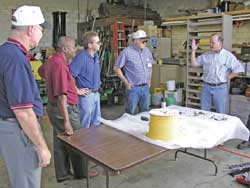
The South Florida Water Management District provided the District with a Mobile Communication and Command Vehicle and staff to alleviate temporary communications problems with staff in the field. South Florida also provided a helicopter and pilot on Sunday, August 15, which allowed Governing Board Chair Watson Haynes II, Moore, Assistant Executive Director Gene Heath and Operations Director Gary Kuhl to assess the extent of the damage.
“Chairman Haynes provided great leadership and support. He was in close contact with staff throughout the storm, then went up to assess the damage,” Moore said.
The St. Johns River Water Management District also helped by sending a crew to assist clearing out drainage systems.
For more than two weeks following the storm, District staff spent thousands of hours assisting local communities by cutting trees, removing debris, clearing drainage systems, transporting water and supplies, securing generators and managing distribution centers.
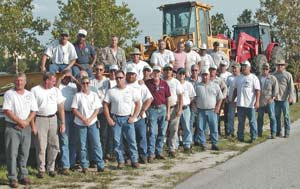
“It was a herculean effort by more than 100 employees, both those who were assigned duties and the many who volunteered to help at distribution centers, unload supplies or make donations. With the help of Tampa Bay Water, we were able to deliver critical water supplies via tanker trucks to Charley’s ground zero,” Moore said.
While the efforts of District staff helped the communities, the work also had a profound effect on staff.
“No one had any gas, nothing,” said Dan Wolthuis, an Operations employee working on a chainsaw/debris clearing crew. “It was like someone came and took all your clothes away right now and you aren’t going to get any more clothes and no one else has any clothes. People were just wandering around, wondering what they were going to do.”
Crises can also bring out the best in people — shared hardships creating moments of selfless sacrifice.
“A mother and three girls pulled into the distribution center on Sunday with a van full of towels, bed linens, pillows, canned goods, health and beauty products — all kinds of commodities,” said Steve Minnis, a District community affairs program manager who was volunteering at a distribution center. “I thanked the woman for her generosity and she said, ‘Don’t thank me, thank my daughter.’ It was her daughter’s eighth birthday party the day before and she had asked her friends to bring donations instead of presents. That brought tears to my eyes.”
Seventeen days after Hurricane Charley, just as requests for District assistance were winding down, another threat loomed on the horizon — Hurricane Frances.
HURRICANE FRANCES
Unlike the fast-moving Category 4 Hurricane Charley, Frances was a lumbering beast that at one point was the size of Texas. The storm slowed to a virtual crawl, then deliberately pushed its way across the peninsula.
“I was concerned for staff,” Moore said. “They had expended a great deal of effort for Charley. Many of them had been working straight through without a break. Here we are three weeks later and they have to deal with another one. But they continued to amaze me. They rose like champions and performed remarkably well before, during and after the storm.”
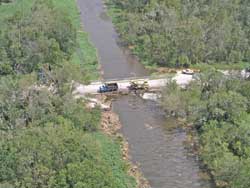
Once again staff was forced to move water as quickly as possible out of full storage systems to create new storage for the 8 to 10 inches of rain forecast for Frances. Staff from multiple departments converged on the fully activated Brooksville EOC as the hurricane crawled across the central portions of the District over the Labor Day weekend.
The impacts of Frances continued to be felt for weeks after the hurricane as runoff from massive watersheds slowly made its way to swollen rivers and lakes. Fallen trees and other debris blocked drainage systems. District staff was once again in the field, clearing debris, operating structures and struggling to minimize flooding. District regulatory crews worked with local governments to expedite approval for temporary fixes to localized flooding and provide technical expertise on long-term solutions.
An exhausted region looked forlornly at a potential knockout punch from Hurricane Ivan. No one could breathe a sigh of relief until the storm decided to move west and spend its destructive power on the Florida panhandle and Alabama.
“It’s difficult to fully express my appreciation and admiration for the work our staff did, especially when you consider that many of them had suffered hurricane damage to their own homes,” Moore said. “They were amazing. We had wonderful assistance from the Governor’s office, the other water management districts, the Department of Environmental Protection, Tampa Bay Water and many, many other organizations.
“Our region and our people were tested. We were knocked around but never out. At the bell, we were still standing.”

